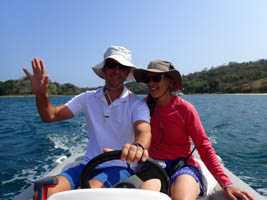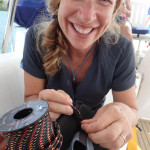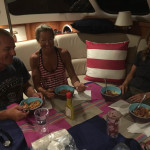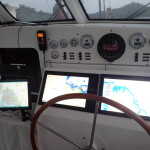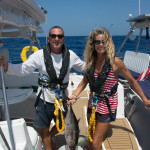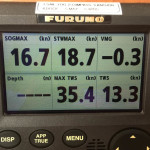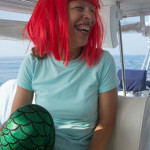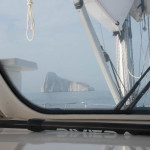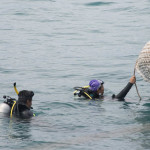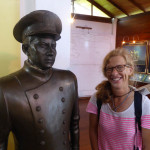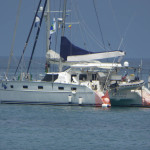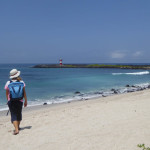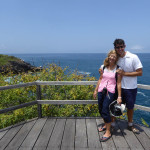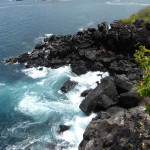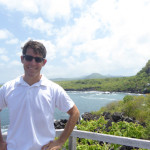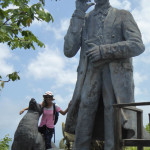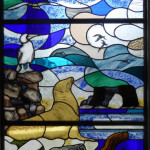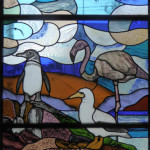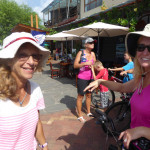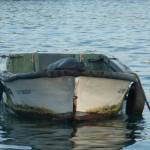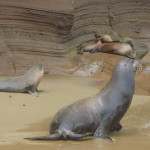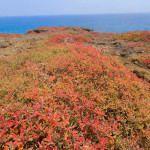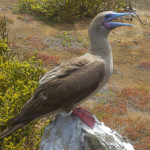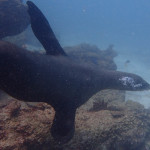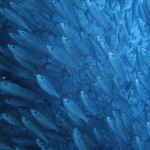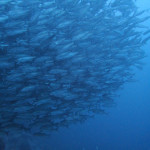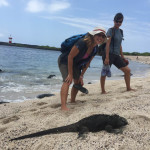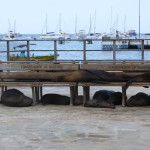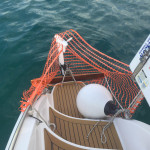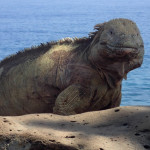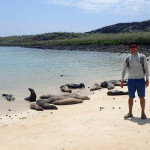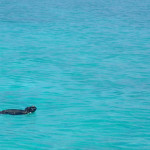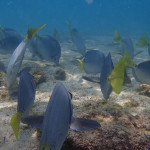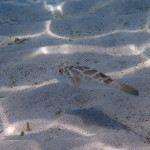Great Friends solve Two Fish problem from afar
Sailboats have little black cups spinning at the top of the mast which calculate the wind speed. Our unit started to die the day before we left on this 3,000 mile passage. Gail tried a few times to fix it but Furuno advised us that the only solution is to mail it in for service or buy a new one (see previous posts).
So we set sail with the thought that many an ocean have been crossed without a wind speed indicator and we should be fine. I had anticipated this contingency back in Florida and had bought a hand-held wind speed detector. This is not ideal but can at least give us a rough idea of when the breeze peaks and when to reef. Here are the shortfalls:
1) The unit only displays apparent wind, not true wind. In other words, the unit is not smart enough to know the boat is moving. It is like a dog putting his head out of the car window on a highway and thinking “It is really windy on this highway”
2) The existing broken unit shows apparent wind direction but not true wind direction. Again the dog thinks “Wow every time I drive this road the wind is always coming from the hood of the car.”
3) The unit measures wind at deck level. We are used to looking at wind numbers from the top of the mast. The difference in these two numbers can be large due to wind shear. We had observed this wind shear effect while the main unit was still working.
So in short, I needed a formula to convert the data from the handheld into the data that I used to receive from the unit. I sent a note to my friends and was blown away with their kindness. They jumped into action and solved my problem in no time. Thanks guys. You are the best. Here is the solution.
How to convert from deck wind to mast wind:
There is no fixed formula for the wind shear; it depends on wind speed and the contour of the surface. v/v_r = (z/z_r)^alpha.
Where v_r is the speed at reference height z_r.
Alpha varies.
unstable air or stormy alpha is very low 0.06.
Neutral air = 0.1
Stable air = 0.27. (this is for open water.. )
But the effect is strongest in light wind and when it is really blowing, there is not much of an effect.
Next up was some trigonometry. I must have been eating paste that day but Gail seems to remember much more of the class.
True Wind speed ^2 = Boat Speed^2 + Apparent Wind Speed ^2 – 2*BS*AWS*cos(Apparent wind angle) and
TWA = sin^-1(sin(AWA)*AWS/TWS)
I am amazed with the cleverness of my friends. So I built a spreadsheet and then I was back in business with all my important sailing numbers. Nothing beats feeling the wind on deck for approximating wind speed, but the computers can keep you honest. Gail then improved the spreadsheet. First, she made it run on Numbers on my iPhone so I could use it at the helm. Second, she made a cool polar card for easy reference. I am better off than before, but still looking for the new part to arrive in the Marquesas.
Thanks so much friends!!
Rally or Race?
Fueled by my own ego and a bit of encouragement from crew and land friends I can become focused on our rally results. So far we were 3rd on the first leg, left Colombia early on leg 2 to explore the San Blas islands and won leg 3. The credit goes to the speed of the boat and the hard working crew. On this three week leg, we avoided the start so we could just cruise across the Pacific. But after 1,000 miles, we are now in a boat to boat race with another Antares. It has been back and forth and exciting. However, I become obsessed and it reduces my fun factor. So I will try to make this more of a rally and less of a race. I do not want to be tweaking the sails for the next 2,000 miles to Hiva Oa. Last night I hand steered with the chute up for 4 hours; that is not a cruiser’s way of life. I think the ARC could play down the race aspect and increase the fun factor. They have excessively formal starts that seem prone to crashes.
SSB Net
Twice a day the rally fleet is on the radio sharing their position. The process is a bit antiquated but I typically enjoy hearing the familiar voices. I was net controller one day and tried to spice up the format. I read a short bit of news and called people by puns of their boat name. A few boats enjoyed the new format but a European boat said he preferred the traditional format.
Because of the wide mileage separation, our SSB radio reception does not reach across the fleet. This forces boats to relay messages. This is tedious but can also provide some amusement for me as I count down the miles until Hiva Oa. When we reach shore I will discuss with other boats how to make these calls more productive.
Landfall in Fatu Hiva or Hiva Oa
Our friends fly out on the 25th of March. At the start it looked like they would have to use their back up reservation on the 27th. The boat has accelerated and there is a chance that we might arrive on the 20th. (18 days for those who placed bets) This opens up the possibility to visit Fatu Hiva. I am enjoying reading Thor Heyerdahl’s book about his time living with his new wife in a hut in Fatu Hiva. I do wish to return to my Captain Cook books, but I took the curse seriously and have suspended further pages until firmly on land.
Diesel update
During the first few days, I was very stressed that we may not have enough diesel. Our thirteen jerry cans seem to be more than enough but who knows what will come over the horizon. Over 1,880 miles a bunch of things could happen. We are forecast to have 15-17 knots for a day and then the breeze will lessen, but might still be good sailing weather. Actually, Gail would prefer it if the boat speed drops to 8 knots. We are currently stuck in a lumpy, boat-slowing current. I was told by my weather router that we should be helped by the ocean current but instead it is slowing us down. Do you bring your umbrella when the weather man says it will be sunny? Weather routers are no less prone to error than their land-based compatriots.
Hydro generator update- Watt & Sea
After a few installation issues this technology has been great. If you are on a passage, this device adds a bunch of amps to your electrical plan. Last night a large portion of the boat’s load was being covered by the hydrogenerator. This means less noise, less smell and more reserve diesel for light air motoring. The device hangs off the stern like a rudder on a dinghy. It has a pin that holds the unit in position. The pin is designed to break, instead of the unit, if the unit hits a submerged object. However, the pin backs out over time until Gail designed a hair tie to keep the pin in place. The unit has been producing 20 amps when the boat speed is 8 knots.
Navionics
I feel very remote when the most popular iPhone navigation app does not have data for the next 1,000 miles. I realize it would be impossible to run aground in 4,000 meters of water but it is insulting for the app to show this entire region as grey.
Head on Collision
I thought this part of the ocean was empty of boats, but I was wrong. We have seen many Japanese long-line fishing boats. In the past 6 hours we have seen 1 foot floating balls that are missing from Japanese long line fishing equipment. It was not easy communicating with them to confirm the location of their deployed tackle and our intention to cross their bow. Last night, Gail noticed a target on the radar with no AIS beacon. She summoned me on deck and we quickly realized this boat was heading at 15 knost towards our friends on Blue Summit. Blue Summit was in the middle of a watch change which added to the excitement. They had assumed the lights were another rally boat but instead it was a fishing boat at ramming speed. Their radar was in sleep mode to conserve power so we were able to give them advice to turn to starboard. We had a great view of the situation since Gail had engaged the ARPA feature on our radar. ARPA looks at the change in position of a radar target and then places a “boat” on the chart plotter. This boat has an arrow indicating direction and speed. The boat was speedily going to run over our friends. But all was sorted out quickly as both boats adjusted course. I am sure that without our call impact would have been avoided but maybe with more stress.
Screecher
Our friends on Field Trip advised us that their new Screecher was a great addition to the head sail inventory. After recovering from the sticker shock, we bought Black Fish. This sail is hugely versatile. I would recommend all new Antares owners to buy this type of sail rather than the traditional screecher. We have found the sail helpful from 70 degrees AWA to 130 AWA. The sail works in winds from 8 to 24 knots. We tend to put the sail away early as the Genoa’s performance starts to converge with the Screecher in higher winds with less stress.
Car Trip Analogy
1,000 miles completed of our passage at sea. Where is our theoretical road trip from NYC to Miami to LA? We just pulled out of Miami- hopefully after some Cuban food – and are 50 miles north of downtown. We are in bumper to bumper traffic traveling at 8 miles an hour. 2,000 miles until LA!
Cooking
We are not great at preserving fresh food. Our bananas died an early death due to two problems. Excessive sun and blunt force trauma. The hammock full of apples was bashing into the banana hammock. Ouch. Two nights ago, team Kozyboat made an Italian feast with Gail’s home made bread. Big winner. Last night the home team took back the galley and served chili dogs. I would not recommend the canned chili or the hot dogs. But the homemade guacamole and fresh tortilla chips were winners. We try to keep the galley water usage down by using paper plates and individually assigned glasses. Our water budget will fall apart today when I turn on the washing machine. We had some success with water capture during a few rain squalls. Much of that water was used to remove stains left by suicidal squid and flying fish. During the night they board, die and then stain the deck. Robin saved two flying fish last night. Another rally boat ate a the flying fish. I would rather eat the canned chili again.
This trip is an absolute joy. Not always comfortable, but never painful. I want it to go faster but also want it to last longer. I am spared the idiocy of the recent news cycle. I still get a daily email from Reuters and the Economist but can avoid hearing certain candidates speak/lie.
I hope you have a wonderful day.
jason
www.twofiscat.com
